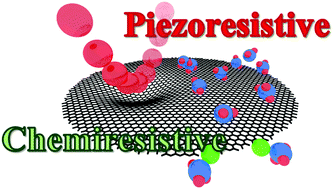Piezoresistive and chemiresistive gas sensing by metal-free graphene layers†
Abstract
Graphene is an ideal candidate to use in various applications as a component in semiconductor devices with excellent properties, such as its atomic thickness, optical transparency, chemical stability, and high electrical and thermal conductivities. The high gas sensitivities of graphene functionalized with metal, metal oxides, and other groups have been improved through intensive research. However, the development of a metal-free graphene gas sensor and clarification of its mechanism still remain a challenge. In this study, H2, CO2, NH3, and He gas sensing performances are demonstrated using two- to multilayered graphene, directly fabricated on a quartz substrate. The sheet resistances of more than 100 graphene layers were considerably changed from 3% to 6% by He gas injection, caused by its piezoresistive property. The anomalous resistance changes by piezoresistivity is a result of electron transfer path changes associated with graphene assemble structure changes by insertion of He gas between graphene crystal units and pressing graphene units. The sheet resistances of the synthesized graphene were found to dramatically change through physical adsorption and chemisorption. The chemisorption of NH3 gas on functional oxygen groups at graphene edges was responsible for the chemiresistive behavior of the material. The gas sensing and piezoresistive mechanisms of graphene determined in this work sheds light on the development of a graphene gas sensor.



 Please wait while we load your content...
Please wait while we load your content...